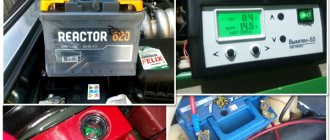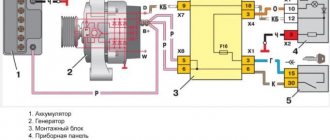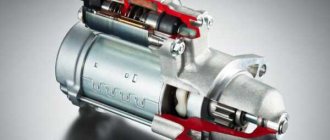Surely every car owner has encountered a situation where a dead battery could not start the engine. In this article, we will give useful tips and show you how to charge your car battery yourself, without the help of special services.
There are a number of reasons why a battery may be discharged. The most common is wear and tear. More than five years is considered a good life cycle for her. However, over time, the ability to hold a charge decreases, and after 3-4 years, car owners may encounter the problem of a dead battery.
There are other reasons for battery drain
:
- short trips that do not allow it to fully charge;
- use of on-board electronic devices during downtime;
- interior lighting left on overnight, dimensions turned on;
- extreme temperatures;
- Installing the wrong battery that does not meet the vehicle's requirements.
Battery charging time may vary depending on the manufacturer, capacity, amplifiers and charger used.
This step-by-step guide will allow you to safely and efficiently charge your battery without outside help. It should be understood that it is strictly forbidden to recharge damaged batteries.
How to charge a battery at home
Step 1.
Make sure your charger is suitable for your specific battery. If it is an AGM or EFB battery, you will need a digital charger.
Step 2.
Clean lead contacts. If they look dirty or corroded, scrub them with a wire brush and remove any remaining debris before connecting the charger.
Check that the liquid inside covers the plates (you may need to add distillate if necessary). This will increase battery life and reduce the risk of excessive off-gassing and bubble formation.
Step 3.
Before disconnecting the battery, as a precaution, make sure you have the PIN codes for the electrical components: navigation system, radio, etc. on hand, as they may need to be reset when reconnected.
Step 4.
It is important to disconnect the negative lead first to prevent electric shock and connect it last. Loosen the clamps or screws that connect the battery to the terminals and remove the retaining mechanism that holds the battery in its case. Be careful not to leak when handling and moving the battery to the charging location.
Step 5.
With the battery placed on a stable, flat surface, connect the charger cables to the battery, matching the positive and negative values.
Once they are secured, connect the charger to the mains. Make sure the battery and charger are as far away from each other as possible.
Step 6.
Before turning on the power for charging, please read the manual that came with the charger. Check whether you need to turn it off manually or whether it will automatically turn off when the charging cycle is complete (this depends on the model, manufacturer).
Self-charging battery
Of course, you can take a dead battery to a service center, but you can charge it yourself, and you don’t need to be a specialist. So, we’ll tell you how to charge your battery at home. The main thing here is to follow safety precautions, so use glasses, chemical-resistant gloves, a working charger, and do not turn the battery on its side or upside down, pay attention to the polarity when connecting the charger! You need to work in a ventilated area, without the presence of open flame.
First, evaluate the color and condition of the electrolyte - by disconnecting the battery from the terminals and removing the covers, look at the color of the “liquid” inside. If it is transparent, then everything is in order, but dregs, and especially floating flakes, can signal a short circuit, and then you will have to change the battery. If everything is fine, then you can start.
There are three charging options, and we will tell you about them all now:
Using DC
This method will require maximum control and regular adjustment of the amperage every 1.5 - 2 hours, as well as the density of the electrolyte.
For example, in order to properly charge a battery with a capacity of 55 or 60 A, you will have to keep the battery connected to the charger at a current of 5.5 - 6 amperes for ten hours. This value of 1/10 (0.1) is taken based on the capacity. For the “sixty” it is equal to - 60 * 0.1 = 6A
With a current of 3 A (multiplier 0.05), you need to charge for 20 hours.
Charging stops when the required density is reached, the battery voltage is 16 volts or the charging current does not decrease within 2 hours.
Constant pressure
More modern chargers are used and the convenience of this method is that you do not need to think about how long to charge the car battery - as soon as the charge is full, the indicator will light up and the charger can be turned off.
Combined method
Here everything is even simpler, first the battery is charged with direct current, and then with voltage. This is the principle on which most modern chargers work. That is, human intervention is required here only for connecting and plugging into the network, and then the charger with automatic shutdown will do all the work itself. For example, the Vympel-30 charger is designed for charging various batteries, however, it has different modes.
Automatic charger "Vympel 30"
"Ambulance"
Sometimes you need to recharge the battery as quickly as possible. In this case, you need to set the current to 12 - 15 A and charge the battery for 20 minutes, which will be enough to start the car. But remember that such express charging will not work if the battery is half discharged or more. And yet, you should not resort to this method very often, this will negatively affect the longevity of the battery.
There is one peculiarity in how to charge a completely discharged car battery. The fact is that modern chargers are protected against short circuits and operate only when there is a reverse voltage of at least 8 volts. A “dead” battery cannot provide it, therefore, we connect the charger to the battery, and then for 1-2 seconds, observing the polarity, we connect any other charged battery to the circuit. We remove the “launcher” and then proceed according to the standard scheme.
Some chargers can be used to assist the battery during engine starting and are called “Starting Chargers”. When the battery is dead or in winter, they are connected to the car battery, turned on and starting the car.
In the old days I came across a starter charger “Electronics ZP 01”. Here
of this device.
How to prepare a battery for charging
To avoid getting an electric shock when removing the battery, make sure that everything is de-energized (this applies to headlights, interior lighting, etc.).
Once you get to the battery, first remove the negative, or ground, cable. It is always painted black. On the top of the battery there are marks with poles: the grounding cable is marked with a negative sign (-), and the power cable, or positive, has a mark (+).
Clean the terminals using a brush and a mixture of baking soda and water to neutralize the acid.
What will you need to charge the battery?
You will need a straightener. This is a device that converts alternating current into direct current. There are portable and transformer models.
If trouble happens on the road and there is no way to use a special charging device, other methods can come to the rescue:
- charge from the cigarette lighter;
- starter;
- use of a donor car.
Features of car battery charging
If battery cells are significantly oxidized, wear safety glasses and a mask to prevent airborne corrosion from entering your eyes, nose, and mouth.
If the battery has removable caps, carefully remove them and check the water level. If there is not enough liquid in any of the cells, add distilled water. Care must be taken here not to overfill the container. Most batteries today do not require maintenance, so opening them for this purpose will not work.
Rules for charging a car battery
- Make sure the charger is turned off.
- Connect the positive charger cable to the positive terminal on the battery.
- Connect the negative cable on the charger to the negative terminal.
- Set the charger to the minimum charging intensity.
- Turn on the charger and set the timer.
- When removing the charger, first de-energize it, remove the positive cable, and then the negative cable.
Rules for charging a car battery
Using the rules for proper battery charging, you can effectively and correctly charge the battery, while ensuring the safety of yourself and others, and also extend the life of the battery. Below we will answer frequently asked questions.
Is it permissible to charge a car battery at subzero temperatures?
Most car owners do not suspect that in winter the battery charge level may not exceed 30%, which is influenced by negative outside temperatures, which affect the discharge. If the battery freezes in the cold, it can fail, especially if the water in it freezes. In a car, the battery will be charged effectively from the generator only when the temperature under the hood is above 0°C. If we are talking about using a stationary charger, then you should let the battery warm up at a room temperature of +25° for several hours.
To avoid freezing of the battery, if in winter the average temperature varies from -25° to -40°, then use a thermal insulating cover.
Is it possible to charge a car battery using a phone charger?
Unfortunately, it is impossible to charge the battery with a mobile phone charger. The first reason for this is the characteristics of the phone charger, which rarely exceeds 5 Volts and 4 Ah. Among other things, with 100% probability you risk causing a short circuit in the battery banks and knocking out plugs in 220V machines. That is why there are special chargers for batteries.
Is it possible to charge a car battery with a laptop power supply?
As practice shows, you can recharge a car battery using a laptop power supply. To do this, you need to follow the sequence of connecting the power supply, car light bulb and battery. Despite the fact that many have succeeded in charging their battery in this way, it is still recommended to use the classic method. Any of the alternative methods is dangerous because the charger and battery may behave inappropriately. If you are interested in this method, be sure to watch the video below.
Charging a car battery with a laptop power supply
Is it possible to charge the battery without disconnecting it from the car's on-board network?
Theoretically, this method of such charging is possible, but subject to certain rules, otherwise it can lead to failure of the entire on-board network of the car. Rules for such charging:
- connect the terminals of the charger and only after that turn it on to a 200V network, and after charging is complete, first remove the terminals, then turn off the charger from the network. If you mix up the sequence, this can result in overvoltage;
- connection of terminals starts with positive, disconnection with negative;
- Before connecting the charger, all power consumers of the car must be turned off; under no circumstances leave the keys in the ignition;
- Carry out the charging process only in a ventilated area.
Types of chargers for charging the battery
There are models for charging a car in the garage or at home. And there is a portable type - an emergency starter, which allows you to start the engine in emergency situations.
Chargers can be manual or automatic. Fully automatic devices determine the degree of battery discharge and independently switch to maintenance mode to protect it from overcharging. According to their purpose, such devices are classified into three groups:
- chargers;
- starting-charging;
- launchers.
A typical home charger consists of a simple transformer and rectifier to convert high voltage AC to 12V.
Basic home chargers will provide an output of 3 to 6 amps when charging a battery that is in fairly good condition. Other models also feature advanced automatic charging features and safety systems to prevent overcharging. They are divided into pulse and transformer.
The pulse device is lightweight and small. It is equipped with an inverter and automatic short circuit protection. This is a more modern and simpler way to recharge batteries at home. Therefore, when considering the option of purchasing such a device, it is better to give preference to the pulse variety.
The transformer type is more bulky and heavier, since it is equipped with a rectifier and transformer.
If the battery is in good condition, the charging speed can be from 3 to 6 amps using a regular home charger. Once the battery expires, it may not hold a charge at all.
Some devices are equipped with a Hi-Low switch to select two charging speeds—usually 3 or 6 amps. If you want to charge the battery in a short time, you will need 6 amps, for a longer charge - 3 amps.
Many modern models are equipped with a charge indicator - a signal lamp or sign showing the charge level in amperes.
Battery charging process
The sequence of charging steps is as follows:
- Turn off the car.
- Make sure the charger is turned off and disconnected.
- Connect the red clamp to the positive terminal.
- Connect the black clamp to grounded metal, the vehicle frame, or engine block.
- Once both clamps are connected, plug the charger into the outlet.
- Turn on the car battery charger.
- The battery will begin to charge. Leave the charger overnight.
- In the morning we turn off the charger.
- Turn on the machine to see if it works.
- If the car still won't start, you may need to replace the battery.
How does charging affect battery life?
The average service life of a more or less high-quality battery is from 3 to 5 years. If the generator is always in good working order, the drive belt is changed on time, and its tension is stable, then there is no need to charge the battery for a long time, but only if you use the car at least 2 times a week. Charging the charger itself does not affect the reduction in battery life compared to the following list:
- undercharging or overcharging. Both have a detrimental effect on the further service life of the battery, for example, because overcharging leads to boiling of the acid and destruction of the cans;
- salt deposits and deep discharge, which will require resuscitation of the battery, and this will significantly reduce the battery life;
- fast or express charging has an extremely detrimental effect on the battery, since in this case large currents act, so this method can only be used in the most extreme cases.
How to properly charge a maintenance-free battery
Everyone knows that the battery is recharged while the car is moving. This is why manufacturers do not recommend leaving machines turned off for long periods of time. But how to properly charge a maintenance-free battery?
Firstly, even if the battery is not in use, it must be charged periodically to extend its life cycle. The principle itself is similar to the process of charging serviced devices. Only here you need to control the charge voltage. It should be no more than 14.4 volts (unless otherwise specified in the manufacturer’s technical data sheet). Otherwise, the electrolyte level will decrease, which will lead to an increase in its density. Unlike a working battery, water cannot be added to an unused battery.
Reasons for battery drain
There are several such reasons, some of which were touched upon in the article about generator repair. So this:
- weak alternator belt;
- The battery terminals are oxidized; how to clean them has already been written;
- generator is faulty;
- frequent, short trips;
- The charging relay is faulty; on some older “classic” models it is located separately from the generator.
How long does it take to charge a car battery?
The timing is determined by the condition and model of the battery itself and the specifics of your charger. If the battery charge is below 11.85 and the charger is delivering 5 A, a full charge from 400 to 500 cold cranking amps will take about 12 hours. It will take half as much time if the charging speed is 10 amperes. The lower the open circuit voltage in the battery and the colder the amplifiers, the longer it will take to charge.
Battery charging time with direct current
Recharging the battery with the built-in generator may require an hour's drive. Car batteries range from 40 to 110 Ah, and alternators range from 45 to 200 amps.
If you are using a battery charger, a 10 amp device will charge it in 4-11 hours, while a 2 amp charger will take 2-4 days. Of course, you don't need to fully charge the battery to get it running.
Battery charging time with constant voltage
The time largely depends on the battery capacity. How to measure battery capacity? To do this, use a special device - a tester, which allows you to determine this parameter within 15 seconds.
Charging time is 12–16 hours, and for large batteries – up to 2 days. With high charging currents and multi-stage charging methods, this period can be reduced to 8–10 hours, but without a full charge.
After a full charge, the battery should not remain at peak voltage for more than 2 days - it should be reduced to the floating level. This is critical for sealed systems because they are less tolerant of overcharging than flooded systems. Charging beyond the specified values converts excess energy into heat, which in turn leads to boiling of the electrolyte.
Symptoms of a dead battery
The battery almost never discharges suddenly, especially since if the electrical equipment is in good working order, the battery is constantly charged from the generator, but sometimes this is not enough. With frequent but short trips, the charge consumption will always be more than the generator can replenish, and sooner or later the charge level will drop to a critical level. Low temperatures can shorten the discharge time, so in the cold season, recharging is needed more often. You can understand in advance that the battery charge is low. Here are the main signs of a dead battery:
- when the ignition is turned on, all indicators go out;
- when the engine is turned off, the car's lighting equipment shines more dimly than usual;
- when you turn the key, you can hear the starter turning several times, but cannot cope with the crankshaft, and loud clicks are heard;
- with a deeper discharge, the starter does not even turn, and the exhaust does not work.
It is worth noting that the cause of all these malfunctions may also be poorly tightened or oxidized terminals.
Checking the battery charge is done with a multimeter or hydrometer; if it shows 12.6-12.8 volts, then the battery is fully charged, if less than 11.8 V, then your battery is completely dead. The hydrometer reading should be 1.27 g/cm3.
Hydrometer for checking electrolyte density
How to determine the battery charge level
When fully charged, car batteries should show a voltage of at least 12.6 V. When the engine is running, the indicator varies from 13.7 to 14.7 volts. If you don’t have a multimeter at hand to determine the voltage, you can check with the headlights on. A dim light indicates an insufficient level that is not enough to drive.
If the lights come on when the engine is turned on, it means the alternator is producing some current, but may not be delivering enough power at idle to keep the battery properly charged. During normal charging, the headlights should be uniformly bright.
In addition, you can measure the state of charge by:
- electrolyte density;
- built-in hydrometric indicator;
- voltage at the battery terminals without load.
How to measure battery charge current with a multimeter
Diagnosing a car battery is very simple, but you will need a tool called a multimeter. It will quickly show whether the battery is low or not. But it's better to spend a little more on a digital device to avoid misinterpretation of the readings.
At first glance, a multimeter looks like a tool that only electrical engineers need. But for the experienced professional or hobbyist, it is an indispensable home tool.
Unlike an AC voltage test, which simply tells you that there is electrical current in the wiring, a multimeter can accurately measure voltage and current for many types of electrical circuits. This allows the user to determine the capacitance of a wiring or verify that current is flowing through a circuit in an expected - safe - manner.
The device must be used when the car is turned off. Using a digital tool, set the dial to constant voltage. Next, connect the black lead of the multimeter to the negative terminal of the battery and the red lead to the positive terminal. Hold each one firmly until the multimeter reads voltage.
A reading of 12.45 V or higher indicates the battery is in good condition. Therefore, the cause of the problem must be sought elsewhere. At a charge level of about 75%, the battery will still be able to start the starter, but this indicator is already a signal for recharging. If the multimeter shows a lower reading, the battery needs to be urgently recharged or replaced (depending on its service life).
How to charge a battery in the cold
In winter, every car enthusiast must take care of the battery. Before the start of the season, it is imperative to check the wear of the generator, the battery itself, and also clarify the charge level using qualitative measurements.
In winter, it is imperative to control the discharge process, otherwise every driver may find himself in an unpleasant situation when in the morning it is simply not possible to start his vehicle. Regular evening check-ins would be ideal. According to research results, it is possible to charge directly in the car, driving for about half an hour, as well as remove the battery and directly restore the energy in it using a good charger.
The driver must control his car completely, including knowing about the individual characteristics of the battery, as well as ensuring a stable charge level.
Measuring the voltage value at the terminals without load
This measurement is made at rest. It will only give correct results if at least 6 hours have passed since the last charge.
Each type of device has its own charging rate.
Electrolyte density measurement
To determine the battery charge in this way, you will need a special device - a hydrometer. A modern battery consists of lead plates, lead oxide, and an electrolyte solution. This solution contains 65% water and 35% sulfuric acid.
The specific gravity increases when charging and decreases when discharging. When the battery discharges, the sulfur moves from the solution to the plates. And vice versa: when the battery is charged, the sulfur returns to solution.
Using a load fork
You can find out the charge level by knowing the voltage at the battery outputs under load.
This is done using a voltmeter. For batteries with a capacity of 40–60 Ah, the resistance value should be 0.018–0.020 Ohm.
Measurements are carried out on the battery, completely disconnected from the charger, 5 - 6 seconds after connecting the plug.
Voltage under load of vehicle electrical equipment
You can check the charge level using the side lights. Considering that the average high beam power is 50 W, the load current will be 10 A.
Another way is to turn on the engine and check the charging of the starter. The voltage here, if everything is in order, does not fall below 9.5 V. If this value is less, you need to leave the battery on recharge, since its charge is not enough for normal operation of the machine.
According to the built-in hydrometric indicator
This method is suitable for batteries equipped with a transparent viewing eye. This is a hydrometric indicator that helps determine the battery charge level without additional tools.
The green indicator indicates a charge level of 60%. This is, in principle, enough to stop the charge and use the car.
A dark indicator indicates insufficient charging. A colorless indicator indicates low water level. At such indicators, it is necessary to add distillate.
How to charge the battery at idle speed
It is possible to charge the battery not only with the help of other drivers or chargers, the car owner can do it himself using the vehicle. To do this, you should stop, start the car and wait at idle for a while.
Before the process, it makes sense to check the voltage in the terminals; charging will take place if the voltmeter shows data of about 13.5V or higher. If the indicator is less, then the battery simply does not consume charge. In this case, it is also possible to get out of the situation by slightly pressing the gas pedal.
Of course, this option must be considered only from an emergency point of view. At the same time, understand that it will be impossible to replenish energy quickly enough. All major electrical appliances should be turned off if possible, such as the cigarette lighter, radio and on-board computer. Wait about 30 minutes minimum, and then do not forget about the need for high-quality, full charging.
How long do you need to drive to charge the battery?
It is not necessary to stand while charging the battery. It will charge perfectly while driving. It makes sense not to accelerate in one place, but just to ride. The trip must be at least half an hour in order for the energy in the battery to be replenished.
In winter, you definitely need to take it for a short drive before parking overnight with a low battery. Only in this case will he be able to park overnight and start the car in the morning.
How often to charge your car battery
If the machine is used regularly and its systems are working properly, the battery will not need to be recharged at all. As a rule, it is needed only if the engine has not been started for a long time (several months). But you need to take into account that as the battery wears out, its capacity decreases and the discharge rate increases.
On average, a battery lasts 5-7 years. The battery will last longer if the machine is used on a daily basis. Extreme temperatures and wear and tear encountered during normal charging and discharging cycles can reduce reserve capacity. When a car is parked for a long time, the battery wears out faster.
Dependence of battery charge and electrolyte density
Basically, we determine the end of battery charging by the readings of the charger or by the voltage at the battery terminals. But they will not be able to determine the exact state of charge of the battery. To find out how charged the battery is, you need to measure the density of the electrolyte. For this purpose there is such a device as a hydrometer. It is inexpensive and is sold in any car store. We recommend that you definitely have it on your household.
Electrolyte density should be measured in all jars. For more information about measuring density and about electrolyte in general, read the article “What acid is in a car battery.” On a fully charged battery, the electrolyte has a density of 1.28-1.3 g/cm3. A completely discharged battery has a density value of about 1.1 g/cm3. Below you can see a table of the dependence of electrolyte density on the state of charge of the battery:
| Electrolyte density, g/cm. cube (+15 degrees Celsius) | Voltage, V (no load) | Voltage, V (with load 100 A) | Battery charge level, % | Electrolyte freezing temperature, gr. Celsius |
| 1,11 | 11,7 | 8,4 | 0 | -7 |
| 1,12 | 11,76 | 8,54 | 6 | -8 |
| 1,13 | 11,82 | 8,68 | 12,56 | -9 |
| 1,14 | 11,88 | 8,84 | 19 | -11 |
| 1,15 | 11,94 | 9 | 25 | -13 |
| 1,16 | 12 | 9,14 | 31 | -14 |
| 1,17 | 12,06 | 9,3 | 37,5 | -16 |
| 1,18 | 12,12 | 9,46 | 44 | -18 |
| 1,19 | 12,18 | 9,6 | 50 | -24 |
| 1,2 | 12,24 | 9,74 | 56 | -27 |
| 1,21 | 12,3 | 9,9 | 62,5 | -32 |
| 1,22 | 12,36 | 10,06 | 69 | -37 |
| 1,23 | 12,42 | 10,2 | 75 | -42 |
| 1,24 | 12,48 | 10,34 | 81 | -46 |
| 1,25 | 12,54 | 10,5 | 87,5 | -50 |
| 1,26 | 12,6 | 10,66 | 94 | -55 |
| 1,27 | 12,66 | 10,8 | 100 | -60 |
| Electrolyte density, g/cm. cube (+15 degrees Celsius) | Voltage, V (no load) | Voltage, V (with load 100 A) | Battery charge level, % | Electrolyte freezing temperature, gr. Celsius |
Using these values, after measuring the density, you can find out exactly how charged the battery is. In general, that’s all I wanted to say about how to properly charge a car battery. All that remains is to remind you once again about observing safety precautions. Before charging the battery yourself, it makes sense to ask advice from more experienced car enthusiasts. You should have your own charger and hydrometer. They are not that expensive and they will always come in handy when operating a car.
Safety precautions when charging the battery
Care must be taken when handling lead-acid batteries. If done incorrectly, the electrolyte in the starter battery may leak or splash out.
Overcharging may result in the formation of explosive hydrogen gas. If your older vehicle is not equipped with a maintenance free battery, a visit to a workshop is recommended.
The charger is charged from AC power and provides a 12V DC output at relatively low voltages, which is the best way to charge a completely discharged battery.
Charging the battery at an excessively high voltage may increase hydrogen production. And this is already a dangerous situation with the subsequent possibility of an explosion.
Regardless, you should wear safety glasses and gloves when servicing, removing, or installing the battery. To prevent short circuits, it is important to avoid connecting terminals in contact with metal or conductive materials, otherwise there is a risk of electric shock or injury.
Selecting a charging method
Charging the battery with constant current or voltage.
For example, there is a battery with an energy capacity of 50 Ah, half charged. You can put it on charge and first set the current to 25 A, then reduce it every minute (full charge = 0). This is the principle on which an automatic charger works, capable of fully restoring the charge in a few hours.
There are chargers that charge in semi-automatic mode. But most car owners prefer the manual method. Let's say the power supply is half discharged, knowing its energy capacity, you can quickly calculate how long it will take to charge. There is a 50 Ampere battery, the losses are 25 A. The current is set to 2.5 A, and after 10 hours the battery is fully charged. If time is not pressing, it is recommended to set the current to 0.5 A - this is the safest and has a positive effect on the life of the battery.
There are several ways to recharge, but usually require control of current and voltage. If the battery operating conditions are observed (deep discharge should not be allowed), the acid model will easily last 3 – 5 years.
Direct current
When charging using this method, you must set the current value to a constant value. But as you recharge, the charging current should be reduced. Instructions:
- The current strength is set on the charger - a value 10 times lower than the actual energy capacity of the battery. For example, if the model is 70 Ah, set the current to 7 A.
- As the battery charges, its voltage will begin to rise. When reaching 14.4 V, the current is halved.
- When the voltage rises to 15 V, the current is again halved.
- The fact that the battery is fully charged is judged by the current and voltage - the characteristics will not change for 1 - 2 hours.
Direct current charging allows you to restore the battery in an average of 10 hours, which is relatively fast. But the method has a number of disadvantages:
- wears out the battery faster;
- a lot of gas is released during the process, especially towards the end;
- When charging at home, in an apartment, it is important to control the process - monitor the current strength and temperature. If the power source has heated up above +40°, it is turned off and continued later.
This method is often not used, as it harms the battery in the long run.
Constant voltage
The option is the opposite of the previous one. The charger is set to a constant voltage, measured in Volts (V), and the current will vary. According to the first, the charging current will be “strong”, especially if the battery is very low. In such a situation, it will not hurt if the charger is equipped with a limiter (usually up to 20 A). Gradually, the current will begin to decrease, since the more capacity is restored, the less recharge the battery needs.
Charging procedure:
- The voltage on the charger is set and fixed to 14.5 V, and charging is connected.
- In this case, constant monitoring is not required, since the voltage is fixed and the current drops.
- The end will be indicated by the current, which will drop to almost 0. There is another way to navigate - the value should be 100 times less than the energy intensity. Let's say with a 70 Ah battery the current will be 0.7 A.
- When charging the power supply using this method, it is recommended to work with a charger equipped with a digital display. Old chargers have an arrow, and it is not always possible to accurately determine the current strength.
- At the end, allow the power source to “rest”, then measure the voltage at the terminals. If it shows 14.5 V, the battery is restored.
Recharging with constant voltage is the correct method, which is the least harmful to the battery. But it also has disadvantages:
- The battery is restored to 80 - 85%. If you set the voltage to 15 V, and not 14.5, it will reach 90%;
- duration – more than a day;
- The method is irrelevant in cold weather, since if the power source is cold, then the resistance inside it will be increased, and it will be difficult to achieve a constant voltage.
If there is nowhere to rush, it is recommended to choose this method.
Battery types
Before we find out how many amperes are usually in a classic 12-volt car battery, let's look at the types of power sources. There are the most popular battery options, such as acid and alkaline. In the first case, metal plates (electrodes) are immersed in a solution of sulfuric acid, and in the second case, the liquid is an alkaline solution.
For northern regions, it is not recommended to use alkaline power sources, as they do not perform well at low temperatures.
Regardless of how many amperes there really are in an alkaline car battery, they are available in two versions: nickel and lithium. The former may contain cadmium or metal hydroxide in combination. Due to their large dimensions, such devices are more in demand on electric forklifts or trucks, since there is more space for the placement of cells with a lower specific current compared to acid analogues.
Lithium power supplies are cheaper to manufacture, but in practice they are very sensitive to low temperatures. This equipment has proven to be in demand in electric vehicles.
Acid batteries are available in the following types:
- Antimony. Lead plates include more than 5% antimony. Although such a battery is capable of withstanding a significant number of discharges/charges, due to other disadvantages it is not used in modern cars.
- Low antimony. They are manufactured using a similar technology as antimony batteries, but with a lower percentage of antimony. They have better practical characteristics.
- Calcium. The plates in them are made with the addition of calcium compounds (without antimony). In some models, the electrodes include silver alloys. Power supplies are quite sensitive to frequent deep discharges, but have stable operating parameters.
- Gel or AGM batteries. This technology assumes that the electrolyte is in a jelly-like (gel) state. Such models are significantly higher in price than liquid analogues - 2–3 times. Their advantages are high resistance to frequent deep discharges and good output parameters, but their disadvantages are the need for a high-quality charger with reduced current parameters and stable consumers.
Number of amperes in a charged car battery
The battery capacity is indicated on the battery case or in the operating instructions (passport). Let's look at how to independently check the indicated amps on your battery. Capacity is important for a motorist, since it can be used to find out how much charge the battery will have time to deliver over a certain period of time. The parameter is measured in ampere hours.
Monitoring is carried out under load and without it. The readings are given by a multimeter, and a regular lamp serves as the load. A charged battery should show good performance when the light stays on for a long time, but if it quickly starts to go out, then the battery is faulty. In such testing, we recommend taking a 35–40 W lamp and holding it for about 2 minutes.
A car battery that was charged before measurements and after loading produced a voltage above 12.4 V can be considered serviceable. If the values are reduced, you should consider purchasing a new power source.
Most power sources located in the engine compartment of passenger cars have a capacity of 55–65 Ah. This is quite enough to start the engine in any weather. However, it is worth considering that a car parked in a garage or parking lot gradually consumes current for small needs, for example, a clock on the dashboard, alarm system, central locking, injection controller, etc. If the total volume of consumers does not exceed 50–70 mA, then this will not prove critical. Otherwise, you need to think about reducing current consumption or buying a more powerful battery that can produce more energy.











